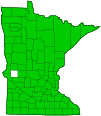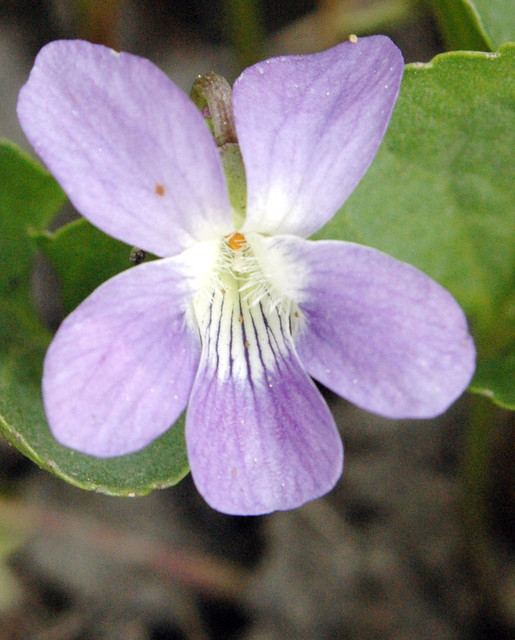common blue violet
(Viola sororia)
Conservation • Wetland • Description • Habitat • Ecology • Use • Distribution • Taxonomy
Description |
Common blue violet is a stemless violet. It is an erect, perennial forb that rises from an underground stem (rhizome). It can be 3″ to 12″ tall but in Minnesota it is usually no more than 8″ in height. The rhizome is short, stout, and horizontal or oblique. It sometimes branches to form colonies. It does not produce above-ground creeping runners (stolons). There is no central stem. A rosette of basal leaves rise directly from the rhizome on up to 6″ long leaf stalks (petioles). The petioles are strongly ascending, hairy, and have a single groove on the upper (dorsal) side. At the base of each petiole is a pair of leaf-like appendages (stipules). The stipules are green, less than ⅝″ long, and separate completely from the petiole. Leaf blades are held at an angle to the petiole. They are broadly egg-shaped to kidney-shaped, rounded or angled at the tip, and heart-shaped at the base. Most are as wide as they are long and most are broadly angled at the tip. They are unlobed except for the heart-shaped base. The sinus at the base of the blade is relatively broad and the lobes do not touch. Summer leaves are 2⅜″ to 5⅛″ wide. The hairiness of the leaves varies between populations, from nearly hairless to conspicuously covered with spreading hairs. The upper surface may be hairy or hairless. The lower surface is usually hairy at least at the base. The margins are toothed with rounded to slightly sharp teeth. One to several leafless flower stalks (scapes) rise from the rootstock at the middle of the rosette. The scape is erect, leafless, usually hairy, and topped with a solitary flower. It is abruptly curved downward near the top. It is usually about 4″ long, shorter than the petioles, and the flowers are usually overtopped by the leaves. Two types of flowers are produced: open, cross-pollinated (chasmogamous) flowers are produced in the spring; and closed, self-fertilizing (cleistogamous) flowers are produced in the summer. Cross-pollinated flowers are ¾″ to 1 3 ⁄16″ long and wide. There are 5 sepals, 5 petals, 5 stamens, and 1 style. The sepals are green and shorter than the petals. The petals are usually medium violet, sometimes purplish or purple, and white at the base. The two upper petals are erect or bent backward. The two lateral petals are spreading, white at the base, and have a tuft of white hairs (beard) near the throat. The lower petal is as long as the lateral petals but is not bearded. It has conspicuous dark violet or dark purple veins near the throat and a hooked, rounded spur at the base. The 5 stamens are orange and have very short filaments. They do not protrude from the throat of the corolla and are concealed by the beards of the petals. The flowers are not fragrant. Self-pollinating flowers are inconspicuous. They occur on shorter scapes that may be arched or lie flat on the ground. The fruit is an egg-shaped to ellipse-shaped, ¼″ to ⅜″ long, hairless capsule with many brown seeds. The capsule protrudes noticeably beyond the persistent sepals. |
Height |
3″ to 8″ |
Flower Color |
Violet or purple |
Similar Species |
Northern bog violet (Viola nephrophylla) leaf blade is fleshy, the underside is usually grayish green or purplish green, and both surfaces are usually hairy. It occurs in wet areas in saturatesd soil. |
Habitat |
Moist to wet. Woods, meadows. |
Ecology |
Flowering |
April to June |
Pests and Diseases |
|
Use |
|
Distribution |
||
|
Sources Biodiversity occurrence data published by: Minnesota Biodiversity Atlas (accessed through the Minnesota Biodiversity Atlas Portal, bellatlas.umn.edu, 1/16/2025). |
|
| 1/16/2025 | ||
Nativity |
||
Native |
||
Occurrence |
||
Widespread and very common |
||
Taxonomy |
|
Kingdom |
|
Division |
Tracheophyta (Vascular Plants) |
Subdivision |
Spermatophytina (Seed Plants) |
Class |
|
Order |
Malpighiales (Nances, Willows, and Allies) |
Family |
Violaceae (violet) |
Subfamily |
Violoideae |
Tribe |
Violeae |
Genus |
Viola (violets) |
Subgenus |
Viola (pansies and violets) |
Section |
Nosphinium |
Subsection |
Borealiamericanae (eastern American blue violets) |
Subordinate Taxa |
|
Northern bog violet Most sources, including USDA PLANTS, NCBI, Gleason & Cronquist, and Voss, do not recognize any varieties. In this classification, common blue violet is Viola sororia and northern bog violet is Viola nephrophylla. The Minnesota DNR (MNTaxa) follows the latter classification, as does MinnesotaSeasons.com. Confederate violet |
|
| confederate violet (Viola sororia f. priceana) | |
Synonyms |
|
Viola chalcosperma Viola × champlainensis Viola floridana Viola × insessa Viola langloisii Viola langloisii var. pedatiloba Viola latiuscula Viola × melissifolia Viola × montivaga Viola × napae Viola palmata var. sororia Viola papilionacea Viola papilionacea var. priceana Viola priceana Viola rosacea Viola septentrionalis Viola septentrionalis var. septentrionalis Viola sororia var. affinis Viola sororia var. priceana Viola × subaffinis |
|
Common Names |
|
bayou violet blue prairie violet butterfly violet dooryard violet downy blue violet hairy wood violet hooded blue violet meadow violet sister violet violet wood violet woolly blue violet |
|
Glossary
Bearded
Bearing one or more tufts of hairs.
Cleistogamous
Automatically self-pollinating. Refers to bud-like flowers that do not open but automatically self-pollinate, or to plants with such flowers.
Petiole
On plants: The stalk of a leaf blade or a compound leaf that attaches it to the stem. On ants and wasps: The constricted first one or two segments of the rear part of the body.
Rhizome
A horizontal, usually underground stem. It serves as a reproductive structure, producing roots below and shoots above at the nodes.
Scape
An erect, leafless stalk growing from the rootstock and supporting a flower or a flower cluster.
Stipule
A small, leaf-like appendage at the base of a leaf stalk or flower stalk.
Stolon
An above-ground, creeping stem that grows along the ground and produces roots and sometimes new plants at its nodes. A runner.
Visitor Photos |
||
Share your photo of this plant. |
||
This button not working for you? |
||
Dan W. Andree |
||
 |
 |
|
… the Common Blue Violets were at NWR Northern Tallgrass Prairie - Pavia Unit … The common blue violets were numerous but small growing in the dense grasses in what seemed slightly more moist areas of that prairie. There are also prairie violets in different areas but never common blue & prairie violets abundant in the same areas. Seemed like it went from mainly all common blue then all prairie violets only once in a while both seen near each other but very sparingly. I only walked the western 1/3 of the NWR so have no info on the rest of that prairie at this time. |
Common Blue Violets... |
|
Meadow Fritillary on Common Blue Violet... This is from a couple years ago one of a couple meadow fritillary I seen. It was during Spring in Norman Co. I just made this from video I shot of it. Meadow Fritillary are small probably the smallest of the fritillary species I have seen. I seen a couple small variegated but also seen a some variegated that were a bit larger than the meadow. |
 |
|
Some Great Spangled are similar in size to some Regals. I think some female regals are just a little larger than the great spangled. While most male regals are smaller than female regals I have encountered a couple male regals nearly the same size as a good sized female regal but most are smaller. I have mistaken female regals seen in a distance for a monarch and vice versa. However close up they are very different. The saying by some the regal is kinda like a monarch dipped in chocolate. To some maybe, but I don’t see it just both uniquely beautiful in their own ways. Regals are rarer. |
||
Luciearl |
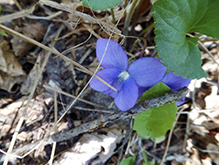 |
At the time I took this photo, I didn't realize there are several types of blue colored violets. I assume it is common blue violet. |
Bill Reynolds |
 |
MinnesotaSeasons.com Photos |
||
 |
||
Plant |
||
 |
 |
|
Inflorescence |
||
|
||
|
||
Inflorescence |
|
|
 |
 |
|
Flower |
Flower |
|
 |
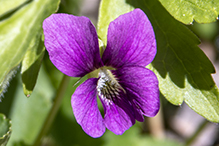 |
|
Flower |
Flower |
|
 |
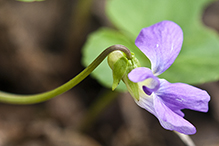 |
|
Spur |
Spur |
|
 |
||
Leaves |
|

Visitor Videos |
||
Share your video of this plant. |
||
This button not working for you? |
||
|
Other Videos |
||
MyNature Apps; Identifying Common Blue Violet, Viola sororia |
About
Uploaded on May 14, 2011 Identifying Common Blue Violet, Viola sororia www.mynatureapps.com |

Visitor Sightings |
||
Report a sighting of this plant. |
||
This button not working for you? |
||
Dan W. Andree |
Location: Northern Tallgrass Prairie NWR, Pavia Unit … the Common Blue Violets were at NWR Northern Tallgrass Prairie - Pavia Unit … |
 |
The common blue violets were numerous but small growing in the dense grasses in what seemed slightly more moist areas of that prairie. There are also prairie violets in different areas but never common blue & prairie violets abundant in the same areas. Seemed like it went from mainly all common blue then all prairie violets only once in a while both seen near each other but very sparingly. I only walked the western 1/3 of the NWR so have no info on the rest of that prairie at this time. |
||
| Dan W. Andree May 2025 |
Location: Norman Co. Mn. |
 |
Dan W. Andree |
Location: Norman Co. Mn. This is from a couple years ago one of a couple meadow fritillary I seen. It was during Spring in Norman Co. I just made this from video I shot of it. Meadow Fritillary are small probably the smallest of the fritillary species I have seen. I seen a couple small variegated but also seen a some variegated that were a bit larger than the meadow. |
 |
Some Great Spangled are similar in size to some Regals. I think some female regals are just a little larger than the great spangled. While most male regals are smaller than female regals I have encountered a couple male regals nearly the same size as a good sized female regal but most are smaller. I have mistaken female regals seen in a distance for a monarch and vice versa. However close up they are very different. The saying by some the regal is kinda like a monarch dipped in chocolate. To some maybe, but I don’t see it just both uniquely beautiful in their own ways. Regals are rarer. |
||
| Luciearl 5/9/2016 |
Location: Cass County At the time I took this photo, I didn't realize there are several types of blue colored violets. I assume it is common blue violet. |
 |
| Bill Reynolds 6/1/2014 |
Location: Pennington County |
 |
MinnesotaSeasons.com Sightings |
||
Avon Hills Forest SNA, North Unit Bertram Chain of Lakes Regional Park Cannon River Turtle Preserve SNA Carpenter St. Croix Valley Nature Center Charles A. Lindbergh State Park Clifton E. French Regional Park Clinton Falls Dwarf Trout Lily SNA Forestville/Mystery Cave State Park John Peter Hoffman Spring Brook Valley WMA Lake Alexander Woods SNA, South Unit Minnesota Valley NWR, Black Dog Unit Minnesota Valley NWR, Chaska Unit Minnesota Valley NWR, Rapids Lake Unit Minnesota Valley State Recreation Area, Lawrence Unit Mound Spring Prairie SNA, North Unit Nerstrand Big Woods State Park Northern Tallgrass Prairie NWR, Pavia Unit Northern Tallgrass Prairie NWR, Rengstorf Unit Prairie Creek WMA, Koester Prairie Unit Robert Ney Memorial Park Reserve Sand Prairie Wildlife Management and Environmental Education Area Stanley Eddy Memorial Park Reserve |

|
Created: 5/4/2006 Last Updated: © MinnesotaSeasons.com. All rights reserved. |
